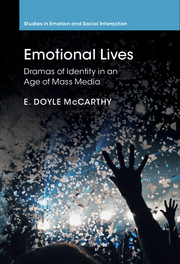Book contents
- Emotional Lives
- Studies in Emotion and Social Interaction
- Emotional Lives
- Copyright page
- Dedication
- Contents
- Acknowledgments
- Preface
- 1 Cultural Sociology and the Study of Emotions
- 2 Emotions and Modern Identity
- 3 Emotional Sites of Death and Destruction
- 4 Mass Emotions in an Age of Mass Media
- Afterword
- Book part
- Notes
- References
- Index
- Series page
- References
References
Published online by Cambridge University Press: 04 May 2017
- Emotional Lives
- Studies in Emotion and Social Interaction
- Emotional Lives
- Copyright page
- Dedication
- Contents
- Acknowledgments
- Preface
- 1 Cultural Sociology and the Study of Emotions
- 2 Emotions and Modern Identity
- 3 Emotional Sites of Death and Destruction
- 4 Mass Emotions in an Age of Mass Media
- Afterword
- Book part
- Notes
- References
- Index
- Series page
- References
- Type
- Chapter
- Information
- Emotional LivesDramas of Identity in an Age of Mass Media, pp. 135 - 160Publisher: Cambridge University PressPrint publication year: 2017



